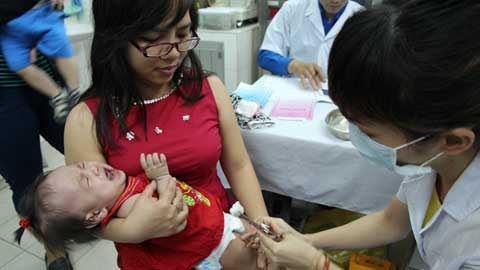3 more vaccines added to the expanded immunization program
Three new vaccines are being prepared for inclusion in the national expanded immunization program: pneumococcal pneumonia vaccine, rotavirus diarrhea vaccine, and HPV cervical cancer vaccine.
 |
| Vaccination is an effective way to prevent diseases in children. In the photo: Hepatitis B vaccine injection for children at the medical station in Ward 2, Phu Nhuan District, Ho Chi Minh City - Photo: NCT |
According to Mr. Nguyen Tran Hien, head of the National Expanded Immunization Project, the Global Alliance for Vaccines and Immunization (GAVI) is ready to support Vietnam with these three vaccines in the first years of introducing them into the program. Mr. Hien said:
- The reason for including these three vaccines in the program is because these are three diseases with high incidence rates, such as viral diarrhea, 56% of children hospitalized in Vietnam are due to rotavirus, and pneumonia is one of the leading causes of death in children, with pneumococcus being one of the main pathogens. The vaccine to prevent cervical cancer caused by HPV virus can prevent some sexually transmitted diseases. These three vaccines are considered to be effective vaccines and GAVI is supporting poor countries with these three vaccines.
"Before the implementation of Japanese encephalitis B vaccination (early 2000s), 60% of encephalitis cases in Vietnam were due to Japanese encephalitis, but statistics in 2013 showed that the rate of Japanese encephalitis B was only 9.1% of the total number of recorded encephalitis cases. Having an additional vaccine is an additional means to effectively prevent the disease."
* Among the diseases that have vaccines to prevent them, why did the program choose the three vaccines mentioned above and not vaccines to prevent diseases like rubella, for example?
- These are vaccines that are considered effective in preventing diseases for children. As for other vaccines such as rubella, from September 2014, Vietnam will implement a vaccination program for 23 million children aged 1-14 years old to receive a free measles-rubella combination vaccine, this program is also sponsored by GAVI. In the immediate future, the campaign will start in September to reduce the incidence rate, reduce transmission from children to adults, reduce congenital rubella syndrome, and move towards eliminating this disease. Elimination is important, for example, measles has been targeted for elimination since 2012, but even in Japan there are still many cases. The problem is to reduce the number of cases in the community but still maintain a high vaccination rate even when the disease has been eliminated, for example, polio in Vietnam has been eliminated since 2000, but up to now, it is still necessary to organize supplementary vaccination in provinces with low vaccination rates.
* The three vaccines mentioned above are all expensive. What is the implementation plan in Vietnam so that it does not financially affect the implementation of existing vaccines, sir?
- In GAVI's support, additional vaccines are also free for a number of years, after which the supported countries will have to pay for this cost. Certainly the budget for the program is very large, my opinion is that the sooner it is implemented, the better, but GAVI requires the Vietnamese Government to have counterpart funds for the program. The cost of HPV vaccine (market price) is about 80 USD (about 1.6 million VND)/injection, each person needs to be injected three times the number of girls who are indicated for vaccination is up to millions of people. We have a detailed plan and GAVI will support until Vietnam is out of the list of supported countries (average income per capita of over 1,500 USD/person). Currently, Vietnam is close to this milestone, so the sooner it is implemented, the sooner it will receive support.
*Among the diseases for which there are and are not vaccines, which one do you think is causing the most difficulty in preventing?
- Regarding vaccine-preventable diseases, in my opinion, measles is the most worrying, while other vaccine-preventable diseases have basically decreased compared to before the implementation of vaccines such as tuberculosis, hepatitis B, diphtheria, whooping cough, and tetanus. As for diseases without vaccines, diarrhea and pneumonia are the most worrying.
According to Tuoi Tre






